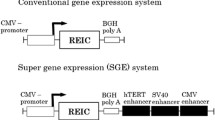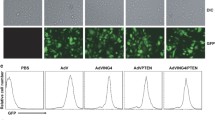Abstract
In this study, we investigated the therapeutic effects of adenovirally-mediated transfer of the sequence of NK4, an antagonist for hepatocyte growth factor (HGF), against human pancreatic carcinoma. HGF has been implicated to play an important role in invasion and metastasis of various human cancers through tumor-stromal interactions. Although NK4 has been shown to block the metastatic behavior of cancer cells, problems with cellular delivery of NK4 must be addressed before it can be used for clinical trials. The effects of NK4 gene transduction mediated by recombinant adenovirus (Ad-NK4) were evaluated in a human pancreatic cancer cell line (SUIT-2) by in vitro scattering assays, invasion assays, and subcutaneous transplantation in nude mice. NK4 transduction markedly inhibited scattering and invasion of SUIT-2 cells stimulated by HGF without affecting cell proliferation in vitro. Furthermore, Ad-NK4 significantly inhibited the growth of tumors transplanted to nude mice. The tumor reduction induced by Ad-NK4 was associated with a decreased number of blood vessels surrounding the tumors. These findings suggest that Ad-NK4 gene therapy may be a unique and promising strategy for the treatment of pancreatic cancer.
Similar content being viewed by others
References
Bramhall SR, Allum WH, Jones AG et al. Treatment and survival in 13,560 patients with pancreatic cancer, and incidence of the disease, in the West Midlands: An epidemiological study. Br J Surg 1995; 82: 111–5.
Poston GJ, Gillespie J, Guillou PJ. Biology of pancreatic cancer. Gut 1991; 32: 800–12.
Warshaw AL, Fernandez-del Castillo C. Pancreatic carcinoma. N Engl J Med 1992; 326: 455–65.
Niederhuber JE, Brennan MF, Menck HR. The National Cancer Data Base report on pancreatic cancer. Cancer 1995; 76: 1671–7.
Nakamura T, Nawa K, Ichihara A. Partial purification and characterization of hepatocyte growth factor from serum of hepatectomized rats. Biochem Biophys Res Commun 1984; 122: 1450–9.
Nakamura T, Nishizawa T, Hagiya M et al. Molecular cloning and expression of human hepatocyte growth factor. Nature 1989; 342: 440–3.
Weidner KM, Behrens J, Vandekerckhove J et al. Scatter factor: Molecular characteristics and effect on the invasiveness of epithelial cells. J Cell Biol 1990; 111: 2097–108.
Jiang WG, Lloyds D, Puntis MC et al. Regulation of spreading and growth of colon cancer cells by hepatocyte growth factor. Clin Exp Metastasis 1993; 11: 235–42.
Matsumoto K, Nakamura T, Kramer RH. Hepatocyte growth factor/scatter factor induces tyrosine phosphorylation of focal adhesion kinase (p125FAK) and promotes migration and invasion by oral squamous cell carcinoma cells. J Biol Chem 1994; 269: 31807–13.
Matsumoto K, Date K, Shimura H et al. Acquisition of invasive phenotype in gallbladder cancer cells via mutual interaction of stromal fibroblasts and cancer cells as mediated by hepatocyte growth factor. Jpn J Cancer Res 1996; 87: 702–10.
Jeffers M, Rong S, Vande Woude GF. Enhanced tumorigenicity and invasion-metastasis by hepatocyte growth factor/scatter factor-met signalling in human cells concomitant with induction of the urokinase proteolysis network. Mol Cell Biol 1996; 16: 1115–25.
Rosen EM, Laterra J, Joseph A et al. Scatter factor expression and regulation in human glial tumors. Int J Cancer 1996; 67: 248–55.
Nakamura T, Matsumoto K, Kiritoshi A et al. Induction of hepatocyte growth factor in fibroblasts by tumor-derived factors affects invasive growth of tumor cells: In vitro analysis of tumor-stromal interactions. Cancer Res 1997; 57: 3305–13.
Inoue T, Chung YS, Yashiro M et al. Transforming growth factor-beta and hepatocyte growth factor produced by gastric fibroblasts stimulate the invasiveness of scirrhous gastric cancer cells. Jpn J Cancer Res 1997; 88: 152–9.
Jiang W, Hiscox S, Matsumoto K et al. Hepatocyte growth factor/scatter factor, its molecular, cellular and clinical implications in cancer. Crit Rev Oncol Hematol 1999; 29: 209–48.
Ebert M, Yokoyama M, Friess H et al. Coexpression of the c-met proto-oncogene and hepatocyte growth factor in human pancreatic cancer. Cancer Res 1994; 54: 5775–8.
Di Renzo MF, Poulsom R, Olivero M et al. Expression of the Met/hepatocyte growth factor receptor in human pancreatic cancer. Cancer Res 1995; 55: 1129–38.
Vila MR, Nakamura T, Real FX. Hepatocyte growth factor is a potent mitogen for normal human pancreas cells in vitro. Lab Invest 1995; 73: 409–18.
Furukawa T, Duguid WP, Kobari M et al. Hepatocyte growth factor and Met receptor expression in human pancreatic carcinogenesis. Am J Pathol 1995; 147: 889–95.
Maehara N, Matsumoto K, Kuba K et al. NK4, a four-kringle antagonist of HGF, inhibits spreading and invasion of human pancreatic cancer cells. Br J Cancer 2001; 84: 864–73.
Date K, Matsumoto K, Shimura H et al. HGF/NK4 is a specific antagonist for pleiotrophic actions of hepatocyte growth factor. FEBS Lett 1997; 420: 1–6.
Date K, Matsumoto K, Kuba K et al. Inhibition of tumor growth and invasion by a four-kringle antagonist (HGF/NK4) for hepatocyte growth factor. Oncogene 1998; 17: 3045–54.
Hiscox S, Parr C, Nakamura T et al. Inhibition of HGF/SF-induced breast cancer cell motility and invasion by the HGF/SF variant, NK4. Breast Cancer Res Treat 2000; 59: 245–54.
Parr C, Hiscox S, Nakamura T et al. NK4, a new HGF/SF variant, is an antagonist to the influence of HGF/SF on the motility and invasion of colon cancer cells. Int J Cancer 2000; 85: 563–70.
Kuba K, Matsumoto K, Date K et al. HGF/NK4, a four-kringle antagonist of hepatocyte growth factor, is an angiogenesis inhibitor that suppresses tumor growth and metastasis in mice. Cancer Res 2000; 60: 6737–43.
Tomioka D, Maehara N, Kuba K et al. Inhibition of growth, invasion, and metastasis of human pancreatic carcinoma cells by NK4 in an orthotopic mouse model. Cancer Res 2001; 61: 7518–24.
Seki T, Ihara I, Sugimura A et al. Isolation and expression of cDNA for different forms of hepatocyte growth factor from human leukocyte. Biochem Biophys Res Commun 1990; 172: 321–7.
Iwamura T, Katsuki T, Ide K. Establishment and characterization of a human pancreatic cancer cell line (SUIT-2) producing careinoembryonic antigen and carbohydrate antigen 19–9. Jpn J Cancer Res 1987; 78: 54–62.
Korst RJ, Bewig B, Crystal RG, In vitro and in vivo transfer and expression of human surfactant SP-A-and SP-B-associated protein cDNAs mediated by replication-deficient, recombinant adenoviral vectors. Hum Gene Ther 1995; 6: 277–87.
McGrory WJ, Bautista DS, Graham FL. A simple technique for the rescue of early region I mutations into infectious human adenovirus type 5. Virology 1988; 163: 614–7.
Holmgren L, O'Reilly MS, Folkman J. Dormancy of micrometastases: Balanced proliferation and apoptosis in the presence of angiogenesis suppression. Nat Med 1995; 1: 149–53.
Paciucci R, Vila MR, Adell T et al. Activation of the urokinase plasminogen activator/urokinase plasminogen activator receptor system and redistribution of E-cadherin are associated with hepatocyte growth factor-induced motility of pancreas tumor cells overexpressing Met. Am J Pathol 1998; 153: 201–12.
Ikeda N, Adachi M, Taki T et al. Prognostic significance of angiogenesis in human pancreatic cancer. Br J Cancer 1999; 79: 1553–63.
Zarnegar R, Michalopoulos GK. The many faces of hepatocyte growth factor: From hepatopoiesis to hematopoiesis. J Cell Biol 1995; 129: 1177–80.
Matsumoto K, Nakamura T. Hepatoeyte growth factor (HGF) as a tissue organizer for organogenesis and regeneration. Biochem Biophys Res Commun 1997; 239: 639–44.
Raynolds LP, Killilea SD, Redmer DA. Angiogenesis in the female reproductive system. FASEB J 1992; 6: 886–92.
Author information
Authors and Affiliations
Corresponding author
Rights and permissions
About this article
Cite this article
Maehara, N., Nagai, E., Mizumoto, K. et al. Gene transduction of NK4, HGF antagonist, inhibits in vitro invasion and in vivo growth of human pancreatic cancer. Clin Exp Metastasis 19, 417–426 (2002). https://doi.org/10.1023/A:1016395316362
Issue Date:
DOI: https://doi.org/10.1023/A:1016395316362




